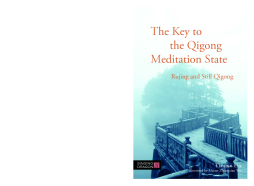
Additional Information
Book Details
Abstract
Exploring classic Qigong meditation from the perspective of modern psychology, parapsychology and cognitive science, Dr. Tianjun Liu defines the mental state of 'still' Qigong in new terms, identifying a specific mental state, Rujing. He examines the psychology of meditation, showing what happens, both mentally and physically, when a person is in a meditation state.
Dr Liu shows how the mastery of Rujing is a fundamental skill vital to the practice of Qigong, and presents a new type of Qigong exercise which takes the achievement of Rujing as its primary goal. His scientific approach to meditation is a breakthrough in this area and will be of interest to practitioners of Qigong and related practices at any level, in addition to anyone with an academic interest in meditation.
Tianjun Liu, O.M.D., is Director of the Qigong research laboratory at Beijing University of Chinese Medicine where he has taught Qigong for more than twenty years. He is also secretary general of the National Qigong Education and Study Association, secretary general of China Academic Society of Medical Qigong, and the first government approved academic mentor for Ph.D. candidates in the field of medical Qigong in China. For the past decade, Dr. Liu has been Editor in Chief of Qigong Study in Chinese Medicine, the only official Qigong textbook used in universities and colleges of traditional Chinese medicine in China.
Table of Contents
| Section Title | Page | Action | Price |
|---|---|---|---|
| The Key to the Qigong Meditation State - Rujing and Still Qigong by Tianjun Liu | 3 | ||
| Foreword by Master Zhongxian Wu | 7 | ||
| Preface to the First Edition | 9 | ||
| Introduction | 11 | ||
| Chapter 1 - Rujing and Qigong | 15 | ||
| Two Concepts | 15 | ||
| Rujing and the Three Adjustments | 19 | ||
| Rujing and the Types of Qigong | 22 | ||
| Chapter 2 - The Realm of Rujing | 29 | ||
| The Problem of Definition | 29 | ||
| The Levels of Rujing | 36 | ||
| The Experience of Rujing | 46 | ||
| Rujing and Motion | 69 | ||
| Chapter 3 - The Mechanisms of Rujing | 73 | ||
| The Mechanism of Mind Adjustment | 73 | ||
| Three Types of Thinking | 77 | ||
| The Mechanism of Breathing Adjustment | 109 | ||
| The Mechanism of Body Adjustment | 122 | ||
| Chapter 4 - The Benefits of Practicing Rujing | 135 | ||
| Curing Disease and Illness | 135 | ||
| Staying Healthy | 142 | ||
| Adjusting Body and Mind | 143 | ||
| Delaying the Aging Process | 147 | ||
| Cultivating Your Latent Potential | 150 | ||
| Understanding the Universe | 153 | ||
| Chapter 5 - Preparatory Work for Rujing | 157 | ||
| Daily Adjustment of Human Body and Mood | 157 | ||
| Preliminaries to Practicing Rujing | 168 | ||
| Chapter 6 - Rujing and Its Components | 188 | ||
| The Basic Principles | 188 | ||
| Mind Adjustment | 195 | ||
| Breathing Adjustment | 215 | ||
| Body Adjustment | 225 | ||
| Coordination and Unity of the Three Adjustments | 235 | ||
| Chapter 7 - Malfunctions in Qigong | 237 | ||
| Identifying Malfunction and Its Causes | 237 | ||
| Chapter 8 - Piao Hua Gong: A Type of Rujing | 255 | ||
| Design Idea | 255 | ||
| Operating Procedure | 258 | ||
| A Few More Points | 265 | ||
| Endnotes | 268 |
